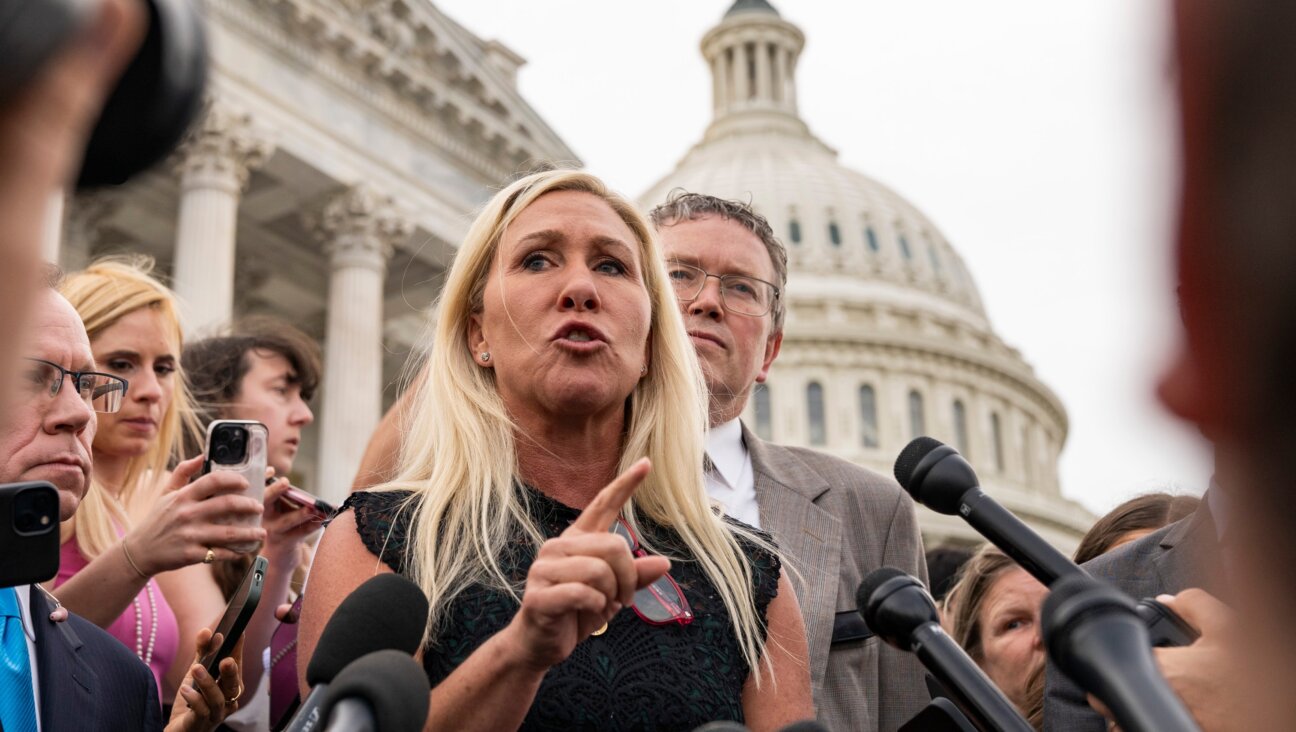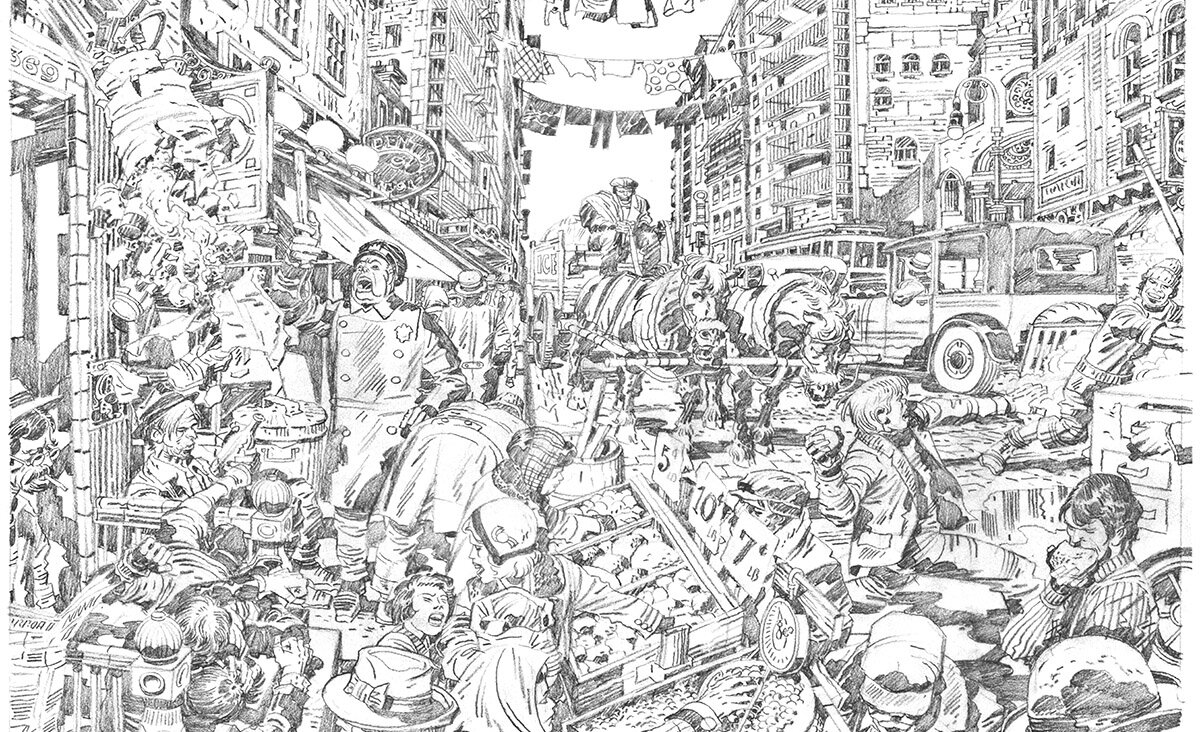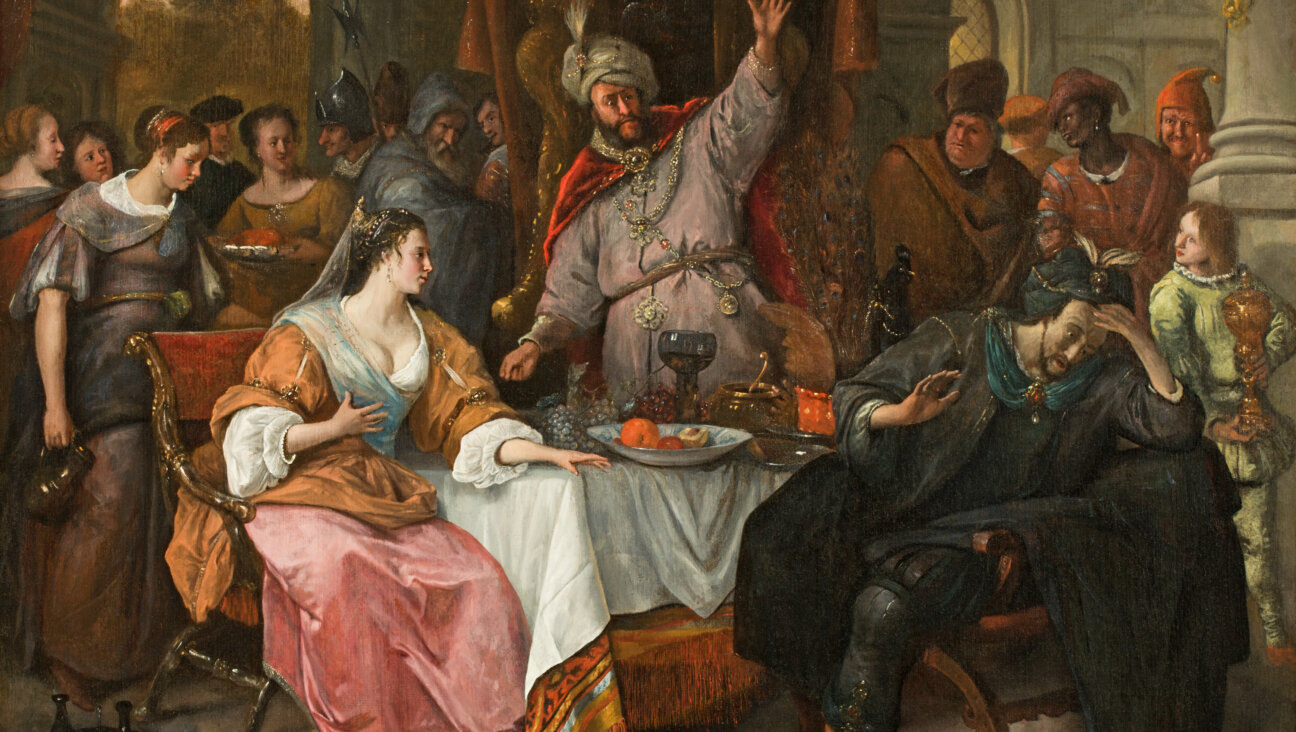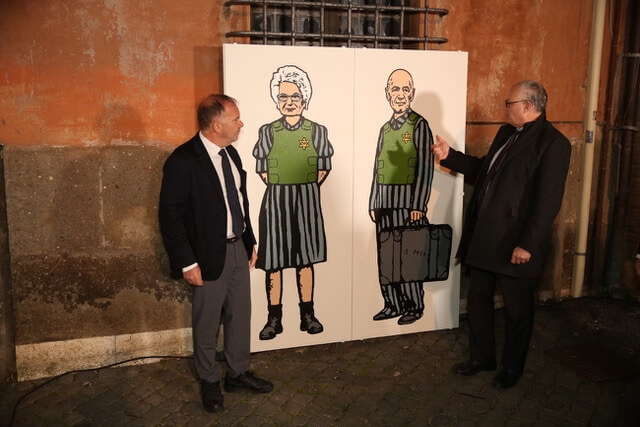In Jerusalem, An Exhibit Interrogates The Myth Of Soviet Jewry’s Israeli Integration

Image by Courtesy of Zoya Cherkassky/Rosenfeld Gallery Tel Aviv
13-year-old Zoya Cherkassky couldn’t look away from the window of her apartment in Kiev. The winter of 1990 was snowy and cold, yet even so, people were waiting in a bread line that stretched out the door of the shop across the street.
“It was weird, because there were lines during that period, but not for bread,” the Ukrainian-born Cherkassky, who immigrated to Israel in 1991, said in an interview. “I felt like I was witnessing something important, a symbol of that era, of life changing and falling apart. I drew the line, thinking to myself that I’d use the drawing for something, someday.”
25 years later, Cherkassky used that sketch as the basis of an oil painting, “Bread” (2015). Both sketch and painting are currently on view at Cherkassky’s first solo exhibition at the Israel Museum in Jerusalem, titled “Pravda.”

Cherkassky, pictured at her solo exhibit at the Israel Museum. Image by Elie Posner/Courtesy of the Israel Museum
Pravda, which translates to “truth” in Russian, was the name of the Communist Party’s official newspaper, which fed its readers a politically expedient alternative reality in the former Soviet Union. In a tongue-in-cheek reference to the Pravda of her youth, Cherkassky’s colorful, large-scale paintings offer an honest look at the experiences of Russian immigrants in Israel, challenging the myth of seamless integration in the Jewish homeland.
The exhibition is saved from bitterness by Cherkassky’s idiosyncratic brand of humor. Amitai Mendelsohn, Curator of Israeli Art at the Israel Museum and curator of “Pravda,” said in an email interview that “Zoya [deals with the Aliyah experience] in a unique way that combines a sense of humor with stark and direct realism, so her work is unique in the Israeli art landscape.”
The hardships faced by Soviet Jews did not dissipate the moment they arrived on the El Al flights that shuttled them to their new country. (Cherkassky’s experience of her own arrival is memorialized in her painting “New Victims” (2016), in which her adolescent self is the first in line to disembark a plane newly landed in Israel.) 900,000 citizens of the former Soviet Union came to Israel in the 1990s, the greatest immigration influx the country had experienced since the mid-1950s.

Zoya Cherkassky’s “New Victims” (2016) Image by Courtesy of Zoya Cherkassky/the Rosenfeld Gallery Tel Aviv
Israel had difficulty absorbing such a large number of newcomers all at once; the group was the equivalent of 20 percent of the country’s population prior to their arrival. It was a challenge to secure adequate housing and employment, and makeshift trailer parks were set up by the Israeli government. The timing of the largest waves of immigration from the former Soviet Union also coincided with the first Gulf War, a period during which Israel was under frequent attack from Iraqi scud missiles and threatened by the potential use of chemical weapons. (“The Chemical Warfare” (2016) depicts a family of four wearing gas masks and playing cards during the then-ubiquitous experience of spending hours in bomb shelters.)
Cherkassky depicts the confrontations between new immigrants from former Soviet countries and Israeli definitions of Judaism in paintings such as “The Circumcision of Uncle Yasha” (2013), in which a middle-aged man claws at an operating table while undergoing a horrifying late-in-life circumcision. In another painting, “Rabbi’s Deliquium” (2016), a rabbi inspects a seemingly kosher household in which the dining table is set for Shabbat, only to find a cooking pot with a pig’s snout peeking out in the refrigerator. (In a small culinary victory for Jews of the former Soviet Union, pork — a dietary staple from home — eventually did make its way into the formerly kosher-centric Israeli kitchen in secular centers such as Tel Aviv.
Cherkassky is well-equipped to tell this story. Her own Jewish descent was questioned when she moved to Israel — apparently, her maternal grandfather was Jewish, but her maternal grandmother was not — and her story is a thread in the fabric of the collective immigration experience of Soviet Jewry. She is also a respected artist in the Israeli art scene, having participated in several group and solo shows in Israel, Berlin and Moscow. Her work has been collected by premier institutions such as the Jewish Museum in New York, Tel Aviv Museum of Art, and Jerusalem’s Israel Museum.

Cherkassky’s “The Chemical Warfare.” Image by Courtesy of Zoya Cherkassky/the Rosenfeld Gallery Tel Aviv
It has been a generation since the first wave of Soviet immigrants first came to Israel in the early 1990s. “The 1.5 generation, a sociological term to define immigrants raised as children in one culture and then planted in another, has come of age,” said Lily Galili, a former Haaretz correspondent and expert on Soviet immigration to Israel who co-authored “The Million That Changed the Middle East” (2013) with Roman Bronfman, in an interview.
“There are more than 200,000 of this age group,” Galili said. “They are the group to write the narrative of this immigration. They, as a collective, have a critical view of both themselves and Israeli society and the courage to express it.”
Distance in both geography and time has aided Cherkassky, who began painting this series while living in Berlin in 2009, in addressing her difficult memories of immigration. “Twenty-five years seems like a reasonable amount of time to be able to look back and try to understand what exactly happened, and what the ramifications are,” Cherkassky said in an interview.
Israel’s Russian community has made strides integrating within Israeli society and the country’s political landscape, but still combats unkind stereotypes. A report published by the Israeli Central Bureau of Statistics in 2015, on the occasion of the 25th anniversary of the Russian Aliyah, seems to indicate that many of those who immigrated in the early 1990s live insular existences. Roughly a quarter of the people who had immigrated to Israel as of 1990, the report stated, in 2015 reported low or nonexistent conversational Hebrew levels. Around half of those polled stated that their close friends were also from the former Soviet Union.
While Jews of the former Soviet Union underwent a challenging Aliyah experience — confronted, all at once, with a war, challenges to their religious identity and difficulty finding housing and employment — Mendelsohn feels that “Pravda” speaks broadly to the history of a country of immigrants.
“The exhibition is very relevant to the generation that came from the former Soviet Union in the 1990s, and I think it is relevant to any Israeli,” Mendelsohn wrote in an email. “Almost every Israeli has experienced, either directly or indirectly (through his or her parents, or the preceding generation), the immigration experience. That’s why this exhibition is specific and personal, yet also collective.”
The Forward is free to read, but it isn’t free to produce

I hope you appreciated this article. Before you go, I’d like to ask you to please support the Forward.
Now more than ever, American Jews need independent news they can trust, with reporting driven by truth, not ideology. We serve you, not any ideological agenda.
At a time when other newsrooms are closing or cutting back, the Forward has removed its paywall and invested additional resources to report on the ground from Israel and around the U.S. on the impact of the war, rising antisemitism and polarized discourse.
This is a great time to support independent Jewish journalism you rely on. Make a gift today!
— Rachel Fishman Feddersen, Publisher and CEO
Support our mission to tell the Jewish story fully and fairly.
Most Popular
- 1

News School Israel trip turns ‘terrifying’ for LA students attacked by Israeli teens
- 2

Culture Cardinals are Catholic, not Jewish — so why do they all wear yarmulkes?
- 3

Fast Forward Why the Antisemitism Awareness Act now has a religious liberty clause to protect ‘Jews killed Jesus’ statements
- 4

Fast Forward Ye debuts ‘Heil Hitler’ music video that includes a sample of a Hitler speech
In Case You Missed It
-

Yiddish קאָנצערט לכּבֿוד דעם ייִדישן שרײַבער און רעדאַקטאָר באָריס סאַנדלערConcert honoring Yiddish writer and editor Boris Sandler
דער בעל־שׂימחה האָט יאָרן לאַנג געדינט ווי דער רעדאַקטאָר פֿונעם ייִדישן פֿאָרווערטס.
-

Fast Forward Trump’s new pick for surgeon general blames the Nazis for pesticides on our food
-

Fast Forward Jewish feud over Trump escalates with open letter in The New York Times
-

Fast Forward First American pope, Leo XIV, studied under a leader in Jewish-Catholic relations
-
Shop the Forward Store
100% of profits support our journalism
Republish This Story
Please read before republishing
We’re happy to make this story available to republish for free, unless it originated with JTA, Haaretz or another publication (as indicated on the article) and as long as you follow our guidelines.
You must comply with the following:
- Credit the Forward
- Retain our pixel
- Preserve our canonical link in Google search
- Add a noindex tag in Google search
See our full guidelines for more information, and this guide for detail about canonical URLs.
To republish, copy the HTML by clicking on the yellow button to the right; it includes our tracking pixel, all paragraph styles and hyperlinks, the author byline and credit to the Forward. It does not include images; to avoid copyright violations, you must add them manually, following our guidelines. Please email us at [email protected], subject line “republish,” with any questions or to let us know what stories you’re picking up.















